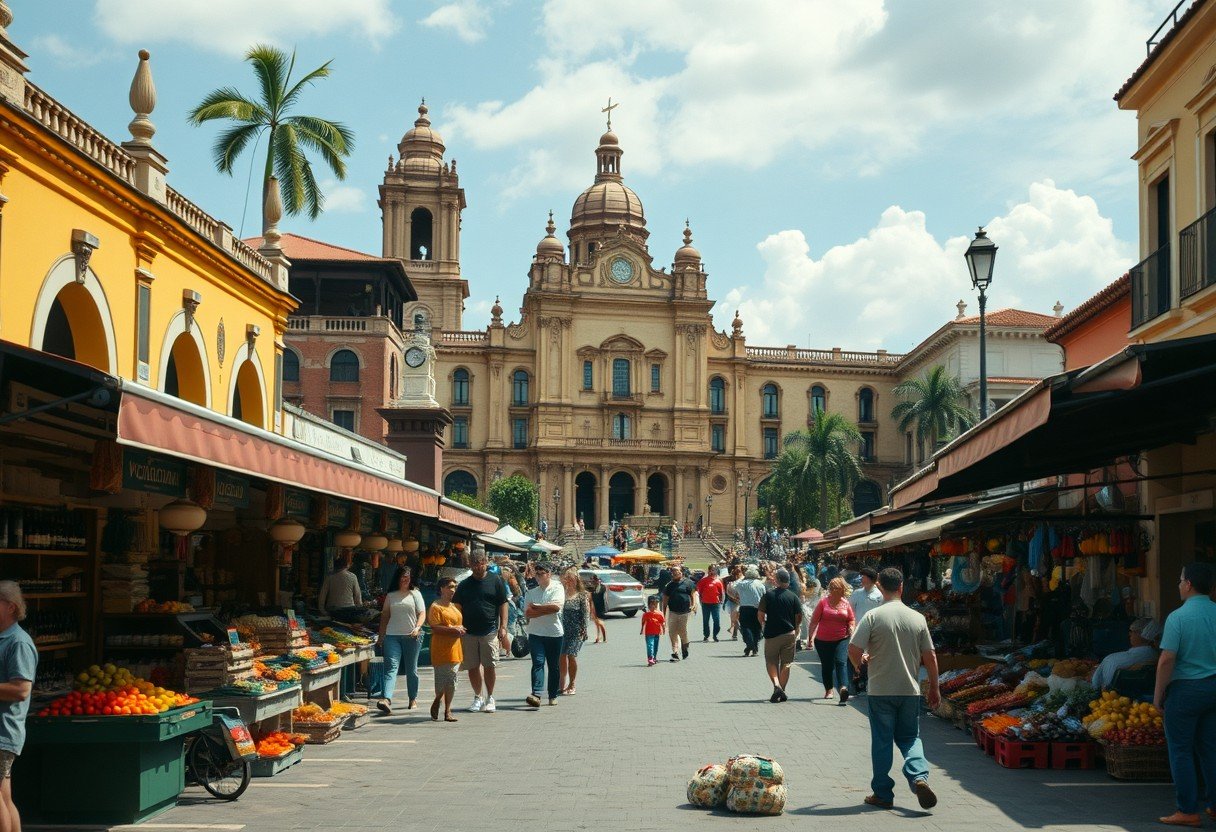The Griffin-Ford Model provides a vital map for understanding the unique structure of Latin American cities. Developed by geographers Ernst Griffin and Larry Ford, this model shows how historical forces, like colonialism, and modern trends, like rapid migration, shape the urban layout. It helps explain why you see a bustling commercial core, wealthy neighborhoods, and sprawling informal settlements all within the same city, revealing a complex story of culture, economics, and society.
What Exactly is the Griffin-Ford Model?
The Griffin-Ford Model, also known as the Latin American City Model, is a framework designed in the 1980s to explain the common spatial patterns found in the region’s cities. It’s not a rigid blueprint but a generalization that highlights how cities are organized.
It suggests that cities grow around a historic colonial core and expand outwards in distinct sectors and zones. This model is crucial because it connects the city’s physical layout to its social structure, showing where different socioeconomic classes tend to live and work. It illustrates a blend of old and new, with a colonial-era center and modern developments pushing outwards.
Understanding this model provides deep insights into the challenges and dynamics of Latin American urban life. It explains the stark contrasts you often see, such as modern skyscrapers next to historic cathedrals or gated communities bordering impoverished neighborhoods.
The Heart of the City: The Central Plaza and CBD
At the very center of the model is the Central Business District (CBD). This is the city’s primary economic engine, packed with corporate headquarters, financial institutions, high-end retail stores, and government offices. It’s the most accessible part of the city, characterized by high-rise buildings and heavy foot traffic.
Adjacent to or within the CBD lies the traditional central plaza. This plaza is a legacy of Spanish colonial planning and remains the cultural and social heart of the city. It is typically surrounded by important landmarks like the main cathedral and government palaces. The plaza serves as a public space for gatherings, festivals, and daily social life, embodying the city’s historical heritage.
The Spine and the Elite: Where Wealth is Concentrated
Extending from the CBD is the commercial spine, a major avenue lined with the best shops, restaurants, and offices. This spine is a prestigious area that caters to the city’s wealthiest residents. It acts as an extension of the downtown area, showcasing modernity and consumerism.
The most affluent residents live in an elite residential sector that fans out from both sides of the commercial spine. This area features high-quality housing, gated communities, and excellent access to services and amenities. The Griffin-Ford Model identifies several key components that illustrate this organization:
- Central Business District (CBD): The main hub for business and commerce.
- Commercial Spine: A corridor of high-end retail and business extending from the CBD.
- Elite Residential Sector: The area with the best housing, bordering the spine.
- Zone of Maturity: An area of established, well-maintained middle-class housing around the CBD.
This structure clearly shows how wealth is concentrated in and around the central core, creating a pattern of socioeconomic segregation that defines the urban landscape.
Life on the Margins: Informal Settlements and the Periphery
As you move away from the city center, the model shows zones of progressively lower income. The periphery, or the outskirts of the city, is characterized by informal settlements, often called favelas, barrios, or squatter settlements. These areas are typically home to recent migrants and the urban poor.
These peripheral neighborhoods often lack basic infrastructure and public services, such as reliable electricity, clean water, and sanitation. Housing is often self-built with whatever materials are available. The informal economy is very strong here, with residents making a living through street vending, small-scale trade, and other unregulated activities. This demonstrates the immense challenge of rapid and often unplanned urbanization.
How History and Migration Shape the Urban Landscape
The structure described by the Griffin-Ford model did not appear overnight. It is the result of centuries of history and decades of intense social change. The colonial foundation, with its central plaza and grid-like street pattern, is still visible in most city cores. This historical layout established the center as the seat of power and prestige.
In the 20th century, massive waves of migration from rural areas to cities dramatically reshaped this colonial structure. People moved in search of jobs and better opportunities, causing cities to expand at an explosive rate. This rapid growth fueled the development of the peripheral informal settlements, as cities could not provide enough formal housing or infrastructure to keep up with the influx of new residents.
A Tale of Two Cities: Comparing Urban Centers
While the Griffin-Ford Model provides a general template, no two Latin American cities are exactly alike. Each city has its own unique geography, history, and culture that influences its development. The model is best used as a tool for comparison to understand these differences.
For example, the proximity of the Andes mountains has shaped Santiago’s growth, while Mexico City’s status as a political and economic powerhouse has led to a massive concentration of resources in its core.
| City | Key Features Reflecting the Model |
|---|---|
| Buenos Aires | Strong European influence in its architecture, with a defined historic core and sprawling suburbs. |
| Mexico City | A massive CBD (Zócalo) that is the political and cultural heart, surrounded by vast and diverse zones. |
| Santiago | A prominent commercial spine and elite sector influenced by its unique valley geography. |
Why the Griffin-Ford Model Still Matters Today
Even though it was developed decades ago, the Griffin-Ford Model remains highly relevant. It provides a clear and effective way to understand the deep-rooted socioeconomic inequalities that persist in Latin American cities. For urban planners and policymakers, the model highlights the urgent need for more inclusive and sustainable development.
By understanding the spatial patterns of poverty and wealth, governments can better target policies to address inequality. This includes improving infrastructure in peripheral areas, formalizing land tenure in informal settlements, and promoting more equitable access to services like transportation, healthcare, and education. The model serves as a constant reminder that a city’s physical layout is deeply connected to social justice and the well-being of its residents.
Frequently Asked Questions
What is the main idea behind the Griffin-Ford Model?
The Griffin-Ford Model explains the layout of a typical Latin American city, showing a central business district and an elite commercial spine surrounded by residential zones that decrease in quality as you move farther from the center. It highlights the impact of colonial history and economic divisions.
What is the role of the central plaza in a Latin American city?
According to the model, the central plaza is the historical, social, and cultural heart of the city. It originated during the colonial period and is typically surrounded by major churches, government buildings, and shops, serving as a key public gathering space.
How does the model show wealth disparity?
The model clearly illustrates wealth disparity through its spatial structure. The wealthiest residents live in an elite sector near the commercial spine and city center, with access to the best services, while the poorest populations inhabit informal settlements on the periphery with inadequate infrastructure.
Does the Griffin-Ford Model apply to every city in Latin America?
No, it is a generalization and not a perfect fit for every city. Local geography, culture, and specific historical events can cause variations, but it provides a useful framework for understanding common patterns of urban development in the region.
Why are informal settlements so common in Latin American cities?
Informal settlements are common due to rapid rural-to-urban migration over the past century. Cities grew too quickly for formal housing and infrastructure to keep pace, forcing new arrivals to build their own homes on the outskirts of the city.









Leave a Comment